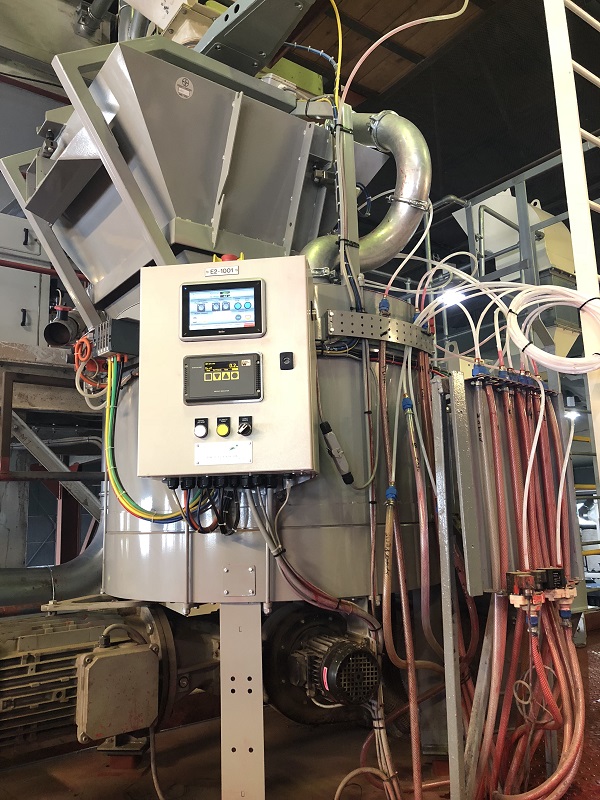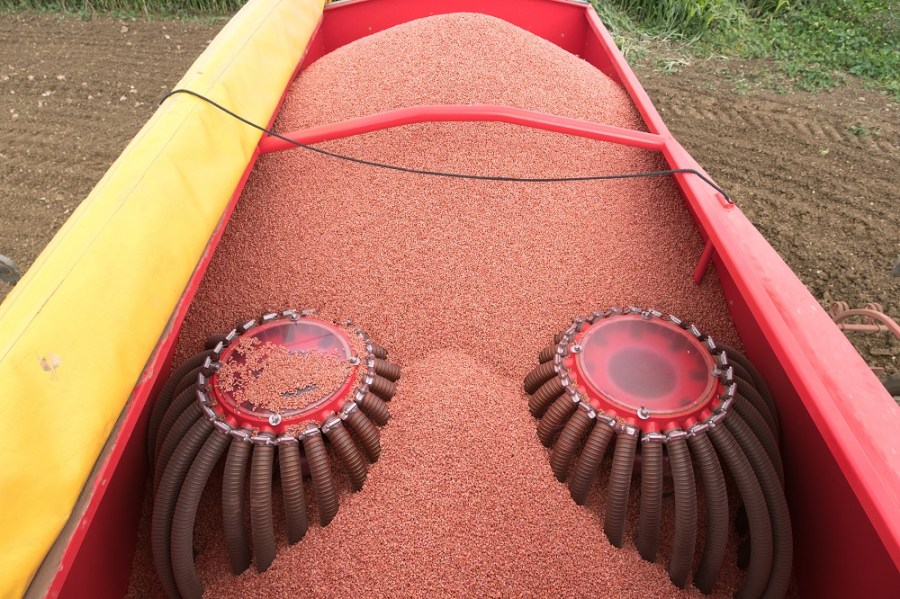Protecting crops against pests and diseases starts before the crop even goes in the ground. CPM looks at the extra precision offered by batch seed treaters.
In the same way that foliar sprays can be optimised, so too can seed treatment applications.
By Rob Jones
Establishment has arguably never been such a challenge to growers, with evolving difficulties controlling blackgrass, dwindling chemistry options and ever-testing weather conditions. Optimising every factor that contributes to establishment helps stack the odds in the crops favour.
Perfecting when and how chemicals are applied to a crop has long been a focus in getting the most out of the chemistry, says Jon Falkingham of Bayer. But he believes discussion on getting the best out of seed treatments is just as valid as considerations to maximise the performance of foliar sprays.
“In the same way that foliar sprays can be optimised, so too can seed treatment applications. After more than 100 years of innovation, seed treatments and the way in which they are applied have come a long way and are now an example of precision agriculture at its very best.”

The Bayer Evolution 1000 batch flow seed treater has a centrifugal drum that mixes at speed to ensure accurate application of a measured dosage of treatment on to each seed
Precision is top of the agenda at Agrii’s seed processing plant in Lincoln, says Kevin Woodman, the company’s national seed production manager. “Seed treatments with lower dose rates are becoming more prevalent but require higher levels of accuracy when applied, so it’s in application technologies where the real advances are coming.”
At the Lincoln site there are two seed treaters in operation, both are batch treaters, which between them can handle 60t of seed per hour, depending on the treatment applied. The batch treaters – Bayer’s Evolution 1000 and Twin Vanguard – contain a centrifugal drum that mixes the seed and seed treatment at speed to ensure accurate application of a measured dosage on to each seed. In contrast, continuous flow treaters, which Agrii operates at one of its other sites, have a constant supply of seed and treatment running through the machine, which is mixed as it passes through.
“Continuous and batch flow treaters are on a fairly even keel. But batch treaters allow more control because you’re able to adjust treatment time per batch to ensure chemical adhesion is optimal. Considering the challenges growers are now facing in the initial stages of crop development, achieving this degree of precision can make all the difference,” explains Kevin.
“All our treaters are serviced and tested by Bayer Engineering to ensure they are operating accurately. Testing is a requirement of The Plant Protection Products (Sustainable Use) Regulations 2012. So in the same way that sprayers need to be serviced and tested, seed treaters must be as well.”
The Lincoln site also uses Bayer’s Data Capture System, designed to document every aspect of the seed treatment process, explains Kevin. “Previously if seed wasn’t treated correctly, there was no way of knowing what the cause was. It could have been a machinery malfunction, chemical formulation issue or even human error. Without knowing the cause, we could never be sure a solution was in place.
“The Data Capture System records everything, from the variety treated and chemical applied, to the length of treatment and amount of chemical used versus what should have been used. This makes it possible to identify any issues and address them as quickly as possible,” he says.
These records are kept, along with samples of every batch treated, for two years to ensure everything sent out to growers can be traced and checked if necessary, long after it is sown. Kevin explains it’s important that the seed treatment operation is assured as part of the European seed treatment assurance (ESTA) scheme, as well as the Trade Assurance Scheme for Combinable Crops
(TASCC) and as a result procedures and regulations are stringent.
“A significant tonnage of seed is treated each season by Agrii’s Lincoln plant. Traceability is a key aspect and sample retention is part of this. As an example, a 2kg sample is taken from every delivery we receive for processing and kept on site for two years.”
These stringent regulations and procedures are representative of the rules now enforced on the seed treatment industry as a whole. As existing products come under pressure and it becomes harder to gain approval for new products, it’s more important than ever to uphold good stewardship practices for treated seed to protect products, now and in the future.
Jonathan Wells is responsible for 650ha in the Barton-upon-Humber region. Growing a mix of winter wheat, spring barley, potatoes, oilseed rape, sugar beet and vining peas, Jonathan’s family farm has been growing seed for Agrii for some 25 years.
A keen believer in the value of seed treatments, Jonathan sees these chemicals as a vital part of his overall establishment strategy. “In order to maximise yield potential, we try to achieve the optimum plant population, and to do that we need to focus on establishment. We carefully choose a seed dressing to address the likely issues the crop will face in a particular field. For example, we’ve used clothianidin on our winter cereals in the past to reduce the impact of BYDV and grain hollowing from slugs.
“For me, every little bit counts in achieving a well-established crop. Seed needs to be treated to the highest standard to get the maximum value out of the chemistry you’re applying and making sure it addresses the problem you’re treating for. Under and overdosing can have significant knock on effects to the crop, so consistency in application is vital.”
Farming without neonicotinoid seed treatments will be a significant challenge for growers over the coming seasons, but good practice is still vital to protect those seed treatment products available now and in the future.
Claire Matthewman, Campaign Manager at Bayer, says “While seed treatments offer the best environmental approach to crop protection, they are still chemicals that must be managed appropriately. By maintaining good practice, growers can help safeguard these crucial crop protection tools for use now and in the future.”
Keeping hidden diseases at bay
Agronomists have reported that loose smut in barley has been on the rise in recent seasons. For many growers this will be a disease they haven’t encountered before. With loose smut infections increasing, it’s topical that in a recent survey carried out by Bayer, almost a third of growers (32%) were unable to identify this seed-borne disease.
For many years control of seed and soil-borne diseases, such as leaf stripe, have been kept at bay by effective seed treatments, so it’s not surprising that some of these diseases are more difficult than others for farmers to identify, says Claire Matthewman, Campaign Manager at Bayer.
Loose smut, a disease of barley, wheat and oats, can be a challenging disease to identify. This is because spores from infected plants land on
healthy plants, infecting the developing grain. But the signs of infection won’t be visible until the diseased seeds are sown and subsequently come into ear themselves. At this stage loose smut is easily recognised as each grain is usually completely replaced by a mass of black fungal spores.
The survey, which asked over 300 growers to identify different seed and soil-borne diseases, also highlighted that while the vast majority of growers (84%) knew that bunt smelt of rotting fish, 35% of respondents were unable to visually identify the disease.
A disease of wheat only, bunt causes the grain in infected ears to be replaced by balls of spores. When these balls are ruptured by the combine, the spores are released as a sooty cloud contaminating not just the seed in the combine but also the soil, nearby crops and the grain store. To identify bunt look for yellow streaks on flag leaves, and stunted plants with dark grey-green ears and slightly open glumes.
Although rare in the UK, 45% of growers were able to correctly identify covered smut, with 31% mistaking the disease for loose smut. These diseases are similar, except that covered smut spores remain in the ear under a thin membrane, rather than being blown off. The membrane is easily broken by the combine, where the infection can then spread onto healthy grain.
The survey also found that only half (51%) of growers could identify seedling net blotch. 24% of respondents mistook net blotch for leaf stripe, which looks very similar in infected young seedlings. However, later leaves infected with net blotch are easier to distinguish, with short brown blotches, or ‘nets’, with a network of darker lines at random on the leaves.
“It can be easy to forget what life was like before effective seed treatments, and some of the really damaging diseases that could hit growers’ crops. However, we’ve found through trials that not all single purpose dressings (SPD) have the same efficacy.
“So it’s important to make sure you use a quality broad spectrum control product like Redigo Pro (prothioconazole+ tebuconazole), which protects against all major seed and soil-borne diseases. Seed treatments are precision agriculture at its best. When they work you don’t see anything, but it makes it easy to forget their importance in keeping these diseases at bay.”
Best practice at drilling
- Use personal protective equipment (PPE) – coverall and gloves should be worn whenever handling treated seeds.
- Prepare seedbed – check that the drill and cultivators are set up correctly to ensure seed burial and avoid leaving seed on the surface.
- Reduce dust – try to minimise movement of the seed bag, and avoid pouring seed from too great a height. Precision vacuum drills should vent safely downwards to minimise emission of abraded seed treatment particles.
- Carry a spill kit – keep a spade and a spare bag with you to recover seed, as well as a canvas sheet for use when calibrating the drill. Clean up spills as soon as possible to prevent seed coming into contact with people or animals.
- Avoid leaving seed on the surface – take care when drilling at the headland, or when passing over dips, as the drill will either stop moving forward or come slightly higher. Ensure that the seed mechanism is shut off a metre before the row ends.
- Store seed properly – seed should be kept in a safe, dry location away from animals. Seed bags are not reusable and must be collected by a licensed waste contractor.
- Wash hands – even when PPE has been worn, hands should be washed immediately after handling treated seed.
Clothianidin usage this coming autumn
The European Commision‘s decision to ban the use of certain neonicotinoid insecticides earlier this year will mean that seed treatments containing clothianidin (Deter and Redigo Deter) will be withdrawn. Bayer are expecting CRD to announce a withdrawal period imminently but say growers will have access to seed treatments containing clothianidin this autumn. The company expects to be able to sell Deter and Redigo Deter until 19 Sept, and growers are likely to have until 19 Dec to plant any treated seed on farm.




